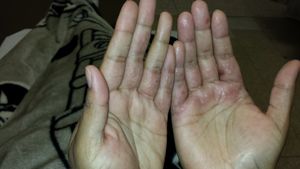Hand-foot-and-mouth disease: Difference between revisions
Ostermayer (talk | contribs) |
Kghaffarian (talk | contribs) (added location lesions) |
||
| Line 8: | Line 8: | ||
*Brief prodrome w/ low fever, anorexia, sore mouth | *Brief prodrome w/ low fever, anorexia, sore mouth | ||
*Oral lesions appear 1-2d later | *Oral lesions appear 1-2d later | ||
**Vesicles on erythematous base | **Vesicles on erythematous base, will then ulcerate | ||
**Painful | **Painful | ||
**Found on buccal mucosa, tongue, soft palate and gingiva | |||
*Hand/foot lesions | *Hand/foot lesions | ||
**Red papules that change to gray vesicles | **Red papules that change to gray vesicles | ||
Revision as of 15:35, 31 August 2014
Background
- Caused by coxsackie virus
- Most frequently in children, but can occur in all age groups
Clinical Features
- Brief prodrome w/ low fever, anorexia, sore mouth
- Oral lesions appear 1-2d later
- Vesicles on erythematous base, will then ulcerate
- Painful
- Found on buccal mucosa, tongue, soft palate and gingiva
- Hand/foot lesions
- Red papules that change to gray vesicles
Differential Diagnosis
- Herpangina
- See also Pediatric Rashes
Workup
- None (clinical diagnosis)
- If unsure, see Pediatric Fever
Management
- No specific therapy for most; self-limited
- NSAIDS and cool liquids for pain
- Encourage good hand hygiene to prevent spread
- Some recommend Magic Mouthwash/oral lidocaine if not tolerating PO intake, although evidence suggests no better than placebo[1]
- In infants, do NOT use oral lidocaine due to risk of lidocaine toxicity and FDA black box warning[2][3]
Disposition
- Home/Outpatient
- Resolves after 7–10 days
See Also
Sources
- ↑ Hopper S. et al. Topical lidocaine to improve oral intake in children with painful infectious mouth ulcers: a blinded, randomized, placebo-controlled trial. Ann Emerg Med. 2014 Mar;63(3):292-9
- ↑ FDA recommends not using lidocaine to treat teething pain. http://www.fda.gov/Drugs/DrugSafety/ucm402240.htm
- ↑ Curtis LA, Dolan TS, Seibert HE. Are one or two dangerous? Lidocaine and topical anesthetic exposures in children. J Emerg Med 2009;37:32-39




